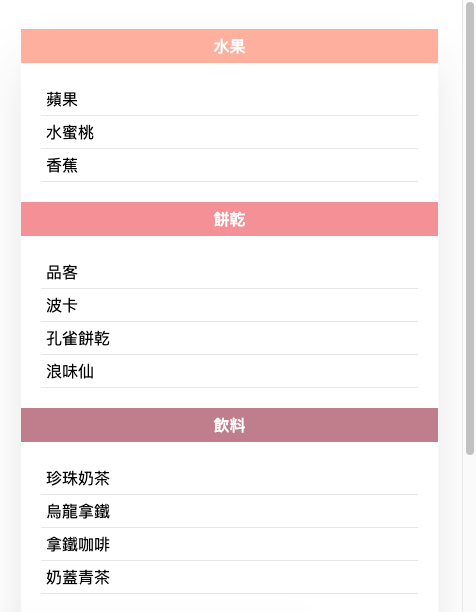
Visual examples of those four possibilities. by CSS-TRICKS
在製作表格時,最常遇到的狀況就是需要在各種螢幕上觀看,但有時單純的橫向捲軸,並未能 100% 提供好的使用者體驗。
本篇文章蒐集了幾種 HTML Table RWD 的方法,提供給需要的朋友。
CSS-TRICKS 也提供了四種 RWD Tables 解決方案,可以看看!
在較小的螢幕上,幫表格加入橫向捲軸(overflow-x),是最簡單的處理方式,css 程式碼如下:
table {
width: 100%;
display: block;
overflow-x: auto;
white-space: nowrap;
}
範例:Bootstrap - Responsive tables
首先需要讓 table 變成 block 區塊元素,再於水平方向的 overflow 讓表格自動判斷是否有超出寬度的內容,如有超出則自動加入水平捲軸(overflow-x: auto)。
white-space: nowrap 這個屬性是讓「文字不會自動斷行」,一定要下才有作用喔!
這樣的方式適合手機版觀看,算是「破壞原本表格排版」的一種。
好處是每個內容都可以清楚對應到標題,缺點是手機版會拉得很長:

Responsive Data Tables by CSS-TRICKS
範例:
<table id="responsive-table">
<thead>
<tr>
<th>First Name</th>
<th>Last Name</th>
<th>Job Title</th>
<th>Joining Date</th>
<th>Total Experience</th>
<th>Relevant Experience</th>
<th>Date of Birth</th>
</tr>
</thead>
<tbody>
<tr>
<td>John</td>
<td>Marks</td>
<td>Developer</td>
<td>January 01, 2013</td>
<td>5</td>
<td>4</td>
<td>June 30, 1985</td>
</tr>
<tr>
<td>Tom</td>
<td>Moody</td>
<td>Developer</td>
<td>December 15, 2012</td>
<td>6</td>
<td>6</td>
<td>May 24, 1980</td>
</tr>
<tr>
<td>John</td>
<td>Marks</td>
<td>Developer</td>
<td>January 01, 2013</td>
<td>5</td>
<td>4</td>
<td>June 30, 1985</td>
</tr>
<tr>
<td>Tom</td>
<td>Moody</td>
<td>Developer</td>
<td>December 15, 2012</td>
<td>6</td>
<td>6</td>
<td>May 24, 1980</td>
</tr>
<tr>
<td>John</td>
<td>Marks</td>
<td>Developer</td>
<td>January 01, 2013</td>
<td>5</td>
<td>4</td>
<td>June 30, 1985</td>
</tr>
<tr>
<td>Tom</td>
<td>Moody</td>
<td>Developer</td>
<td>December 15, 2012</td>
<td>6</td>
<td>6</td>
<td>May 24, 1980</td>
</tr>
</tbody>
</table>
table {
border-collapse: collapse;
border: 1px solid #cdcdcd;
font: normal 12px arial;
width: 100%;
}
td,
th {
border: 1px solid #cdcdcd;
padding: 8px;
}
@media only screen and (max-width: 760px),
(min-device-width: 768px) and (max-device-width: 1024px) {
table,
thead,
tbody,
th,
td,
tr {
display: block;
}
thead tr {
position: absolute;
top: -9999px;
left: -9999px;
}
tr {
border-bottom: 2px solid #690461;
}
td {
border: none;
border-bottom: 1px solid #eee;
position: relative;
padding-left: 50% !important;
text-align: left !important;
}
td:before {
position: absolute;
top: 6px;
left: 6px;
width: 45%;
padding-right: 10px;
white-space: nowrap;
font-weight: bold;
}
td:nth-of-type(1):before {
content: "First Name";
color: #0e9893;
}
td:nth-of-type(2):before {
content: "Last Name";
color: #0e9893;
}
td:nth-of-type(3):before {
content: "Job Title";
color: #0e9893;
}
td:nth-of-type(4):before {
content: "Joining Date";
color: #0e9893;
}
td:nth-of-type(5):before {
content: "Total Experience";
color: #0e9893;
}
td:nth-of-type(6):before {
content: "Relevant Experience";
color: #0e9893;
}
td:nth-of-type(7):before {
content: "Date of Birth";
color: #0e9893;
}
}
這樣的方式不論手機版或電腦版都適合閱讀,也是「破壞原本表格排版」的一種。
但這樣的方式也有一個缺點:表格內容文字必須限制一行,若有兩行或以上將無法適用於此排版。

↑ 電腦版顯示
↑ 手機版顯示
筆者的螢幕錄影.gif 一直無法連結到鐵人賽文章,不知道為何上面的可以,只好截兩張圖示意 ( ´;ω;` )
這是筆者目前使用率最高的解決方法,雖然對於內容較多的表格不適用(會需要下太多次 data-title),但以少內容的表格來說很適合手機版閱讀,且內容不限制一行或多行,也可以使用 ol、ul、li 都沒問題。
範例:筆者的 Codepen - Responsive Tables
<div class="table-wrapper">
<table class="table">
<thead>
<tr>
<th>水果</th>
<th>餅乾</th>
<th>飲料</th>
<th>伴手禮</th>
</tr>
</thead>
<tbody>
<tr>
<td data-title="水果">
<ul>
<li>蘋果</li>
<li>水蜜桃</li>
<li>香蕉</li>
</ul>
</td>
<td data-title="餅乾">
<ul>
<li>品客</li>
<li>波卡</li>
<li>孔雀餅乾</li>
<li>浪味仙</li>
</ul>
</td>
<td data-title="飲料">
<ul>
<li>珍珠奶茶</li>
<li>烏龍拿鐵</li>
<li>拿鐵咖啡</li>
<li>奶蓋青茶</li>
</ul>
</td>
<td data-title="伴手禮">
<ul>
<li>鳳梨酥</li>
<li>乳酪蛋糕</li>
<li>杏仁餅</li>
</ul>
</td>
</tr>
</tbody>
</table>
</div>
/* ---------------------------- */
/* Table Styles
------------------------------- */
.table-wrapper {
margin: 50px;
box-shadow: 0px 35px 50px rgba(27, 31, 49, 0.1);
}
.table {
border-collapse: collapse;
width: 100%;
background-color: white;
}
.table td,
.table th {
text-align: center;
padding: 10px;
}
.table td {
border-right: 1px solid #f8f8f8;
}
/* thead th color
------------------------------- */
.table thead th {
color: #ffffff;
background: #ffb4a2; /* 指定第一個和預設的標題顏色 */
}
.table thead th:nth-child(2) {
background: #e5989b; /* 指定第二個標題顏色 */
}
.table thead th:nth-child(3) {
background: #b5838d; /* 指定第三個標題顏色 */
}
.table thead th:nth-child(4) {
background: #6d6875; /* 指定第四個標題顏色 */
}
/* table ul
------------------------------- */
.table ul {
padding: 20px;
margin: 0;
text-align: left;
}
.table ul li {
border-bottom: 1px solid #e7e7e7;
padding: 5px;
position: relative;
list-style-type: none;
}
/* Responsive
------------------------------- */
@media (max-width: 767px) {
.table-wrapper {
margin: 30px 15px;
}
.table thead {
display: none;
}
.table td {
display: block; /* 一定要下! */
padding: 0;
}
.table td:before {
content: attr(data-title); /* 顯示 data-title */
display: inline-block;
width: 100%;
font-weight: 500;
padding: 6px 0;
color: #ffffff;
background: #ffb4a2; /* 指定第一個和預設的標題顏色 */
}
.table td:nth-child(2):before {
background: #e5989b; /* 指定第二個標題顏色 */
}
.table td:nth-child(3):before {
background: #b5838d; /* 指定第三個標題顏色 */
}
.table td:nth-child(4):before {
background: #6d6875; /* 指定第四個標題顏色 */
}
}
換句話說就是使用 div 或其他標籤來達到 table 的排版效果,好處是彈性度較大,CSS-TRICKS 的範例 就是使用 div 來達到各種 RWD 效果。
範例:
以上為筆者收藏的幾種 RWD Table 方法,希望可以幫助到需要的朋友:)
